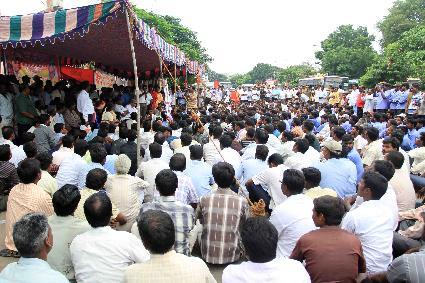Submitted by World Revolution on
Up to 100 million workers were involved in a one day strike in India on 28 February. A strike that hit a number of sectors across the country was hailed by some as one of the world’s biggest ever strikes. Called by the eleven central unions (the first time they’d acted together since independence) and 5000 smaller unions, the demands included a national minimum wage, permanent jobs for 50 million contract workers, government measures to tackle inflation (which has been over 9% for most of the last two years), social security benefits such as pensions for all workers, better enforcement of labour laws, and an end to selling off stakes in state-owned enterprises. The fact that millions of workers were prepared to participate showed that, for all the talk of India’s economic ‘boom’, it’s not experienced by the working class.
However, the demands, as put forward by the unions, all make the assumption that the capitalist government of India is capable of responding to the needs of other classes. There are also the erroneous ideas that it could tackle inflation or that stopping the sale of public-sector assets would somehow benefit the working class. And anyway the bourgeoisie has its own problems to worry about. For example, the IT and call centre industry in India is dependent on US companies for 70 percent of its business. This sector has been traumatised by the impact of the economic crisis. No longer a growth area and source of great profits it’s experienced widespread wage and job cuts. This pattern is repeated in many other sectors. The Indian economy can’t stand aside from the world economy and its crisis.
On this occasion the unions all acted together, but they have not been backward in the past in mobilising protests against government measures. There have been 14 general strikes since 1991. But recently we have seen more examples of workers acting on their own initiative and not waiting for union directives.
For example, between June and October 2011 thousands of workers took part in factory occupations, wildcat strikes and protest camps at Maruti-Suzuki and other car factories in Manesar, a ‘boom town’ in the Delhi region. After a union-agreed settlement in early October 1200 contract workers were not rehired and so 3500 workers went back on strike and occupied the car assembly plant in solidarity. This led to further solidarity actions by 8000 workers in a dozen or so other plants in the area. It also led to some sit-in protests and the formation of general assemblies to avoid the sabotage of the unions.
The rediscovery of the general assembly as the most appropriate form for ensuring the broadest participation of workers and the widest exchange of ideas is a tremendous advance for the class struggle. The general assemblies of Maruti-Sazuki in Manesar were open to everyone and encouraged everyone to participate in shaping the direction and goals of the struggle. It didn’t involve millions of workers, but showed that the working class in India is clearly part of the current international development of the class struggle.
Car 3/3/12







 del.icio.us
del.icio.us Digg
Digg Newskicks
Newskicks Ping This!
Ping This! Favorite on Technorati
Favorite on Technorati Blinklist
Blinklist Furl
Furl Mister Wong
Mister Wong Mixx
Mixx Newsvine
Newsvine StumbleUpon
StumbleUpon Viadeo
Viadeo Icerocket
Icerocket Yahoo
Yahoo identi.ca
identi.ca Google+
Google+ Reddit
Reddit SlashDot
SlashDot Twitter
Twitter Box
Box Diigo
Diigo Facebook
Facebook Google
Google LinkedIn
LinkedIn MySpace
MySpace